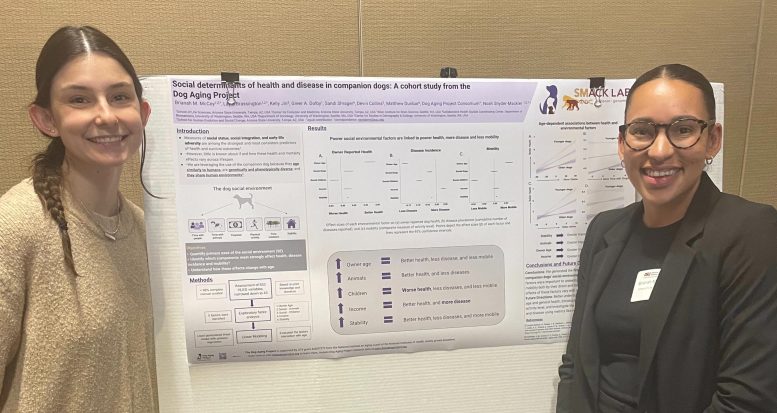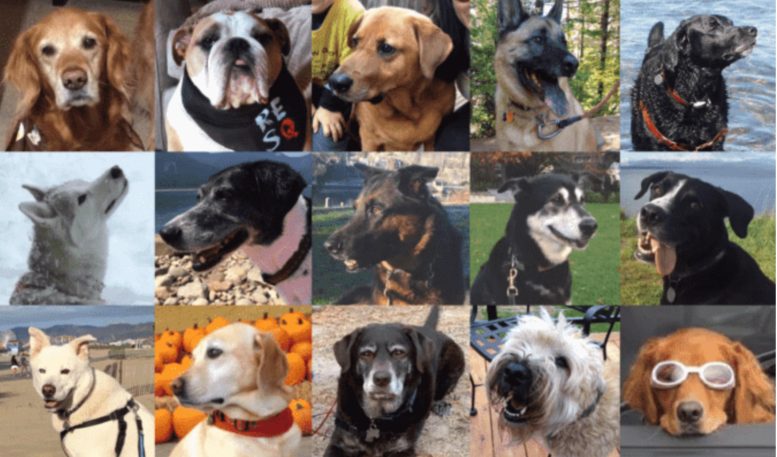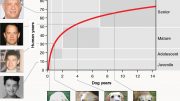
According to the largest survey and data compilation of its kind, fit and healthy dog largely depends on its social support network, with this factor having five times the impact of financial factors, household stability, or the owner’s age.
Surveying a cohort of 21,000 dogs, the Dog Aging Project uncovers a correlation between increased social support and improved overall well-being.
What contributes to a healthy, active dog? How does a dog’s environment play a role in its lifespan?
“People love their dogs,” said ASU School of Life Sciences assistant professor Noah Snyder-Mackler. “But what people may not know, is that this love and care, combined with their relatively shorter lifespans, make our companion dogs a great model for studying how and when aspects of the social and physical environment may alter aging, health, and survival.”
Now, the largest survey and data compilation of its kind, which involved over 21,000 dog owners, has shed light on the social determinants that could be connected to healthier aging in our cherished canine friends. Notably, the extent of a dog’s social support network emerged as the most influential factor on improved health outcomes—having an impact five times greater than financial conditions, household stability, or the owner’s age.

Arizona State University School of Life Sciences MSc student Layla Brassington (left) and PhD student Bri McCoy (right), helped carry out a comprehensive analysis of a detailed survey of dog owners, which totaled a breathtaking number, 21,410 dogs. The study attempted to find key social aspects for healthy lifestyles to help explore the science behind dog years in a large, community-science endeavor called the Dog Aging Project. Credit: Dr. Noah Snyder-Mackler, ASU School of Life Sciences
Led by Snyder-Mackler, Ph.D. student Bri McCoy, and MSc student Layla Brassington, they carried out a comprehensive analysis of a detailed survey of dog owners, which totaled a breathtaking number, 21,410 dogs. The study attempted to find key social aspects of healthy lifestyles to help explore the science behind dog years in a large, community-science endeavor called the Dog Aging Project. The Dog Aging Project is a partnership led by the University of Washington and Texas A&M schools of medicine that includes more than a dozen member institutions–including ASU–around the nation.
The main goal of the Dog Aging Project is to understand how genes, lifestyle, and the environment influence aging and disease outcomes. More than 45,000 dogs are now enrolled in the project across the U.S.
“This study illustrates the incredibly broad reach of the Dog Aging Project,” said Daniel Promislow, project co-director and principal investigator. “Here, we see how dogs can help us to better understand how the environment around us influences health, and the many ways in which dogs mirror the human experience. Just as with people, dogs in lower-resource environments are more likely to have health challenges. Thanks to the richness of the data the Dog Aging Project is collecting, follow-up studies will have the potential to help us understand how and why environmental factors affect health in dogs.”
McCoy, Brassington, Snyder-Mackler, and the team drew on a large survey that asked each owner questions about themselves and their pup: ranging from physical activity, environment, dog behavior, diet, medications and preventatives, health status, and owner demographics. Using these questions, they identified 5 key factors (neighborhood stability, total household income, social time with children, social time with animals, and owner age) that together, helped explained the makeup of a dog’s social environment and were associated with dog wellbeing.

The Dog Aging Project aims to better understand healthier aging for people’s beloved canine companions. More than 45,000 dogs of all breeds and sizes have enrolled in the study. Credit: Dog Aging Project, University of Washington
They found that the dog’s lived and built environment predicted their health, disease diagnoses, and physical mobility–even after controlling for the dog’s age and weight. More specifically: Financial and household adversity were linked to poorer health and reduced physical mobility, while more social companionship, such as living with other dogs, was associated with better health. These effects of each environmental component were not equal: the effect of social support was 5 times stronger than financial factors.
“This does show that, like many social animals–including humans, having more social companions can be really important for the dog’s health,” said ASU graduate student McCoy.
Among the more surprising results were: 1) a negative association between the number of children in the household and dog health, and 2) that dogs from higher-income households were diagnosed with more diseases.
“We found that time with children actually had a detrimental effect on dog health,” said Brassington. “The more children or time that owners dedicate to their children likely leads to less time with their furry children.”
“You can think of it as a resource allocation issue, rather than kids being bad for dogs,” said McCoy.
The second counterintuitive finding points to the role that finance plays in the opportunities for disease diagnosis. Dogs from wealthier households have better access to medical care, leading inadvertently to more disease diagnoses. Because the dogs who live in households with wealthier owners might seek veterinary care more frequently, and their owners have the funds to pay for additional tests, this leads to more diseases identified.
Their results remained largely consistent when accounting for health and disease differences between pure and mixed breed dogs, as well as among specific breeds.
One important caveat and cautionary note on the data is the nature of surveys. Since these are owner-reported, there may be some error, bias, and/or misinterpretation of survey questions.
Their next steps will begin to explore if there are any links between the survey and underlying physiology.
“We now want to understand how these external factors are getting under the skin to affect the dog’s health–how is the environment altering their bodies and cells?,” said Snyder-Mackler.
A subset of the dogs, about 1,000 are part of a more focused cohort where Snyder-Mackler and his collaborators are collecting blood and other biological samples over many years to uncover these clues.
“In future research, we will look at electronic veterinary medical records, molecular and immunological measures, and at-home physical tests to generate more accurate measures of health and frailty in the companion dog,” said Snyder-Mackler.
“But the take-home message is: Having a good network, having a good social connectedness is good for the dogs that are living with us,” said McCoy. “But the structure and equities that are in our society also have a detrimental effect on our companion animals as well. And they are not the ones thinking about their next paycheck or their health care.”
And what is good for dogs may just echo what may be a good prescription for people to live healthier lives.
“Overall, our study provides further evidence for the strong link between the social environment and health outcomes that reflects what is known for humans,” said Snyder-Mackler. “We need to focus more attention to the role of the social environment on health and disease, and continued investigation of how each environmental factor can contribute to more years of healthy living (i.e., “healthspan”) in both companion dogs and humans.”
Reference: “Social determinants of health and disease in companion dogs: A cohort study from the Dog Aging Project” by Brianah M McCoy, Layla Brassington, Kelly Jin, Greer A Dolby, Sandi Shrager, Devin Collins, Matthew Dunbar, Dog Aging Project Consortium, Audrey Ruple and Noah Snyder-Mackler, 13 May 2023, Evolution, Medicine, and Public Health.
DOI: 10.1093/emph/eoad011









For those of us not trained in social science, it would be nice if you could define what “Having a good network, having a good social connectedness” means with respect to dogs.